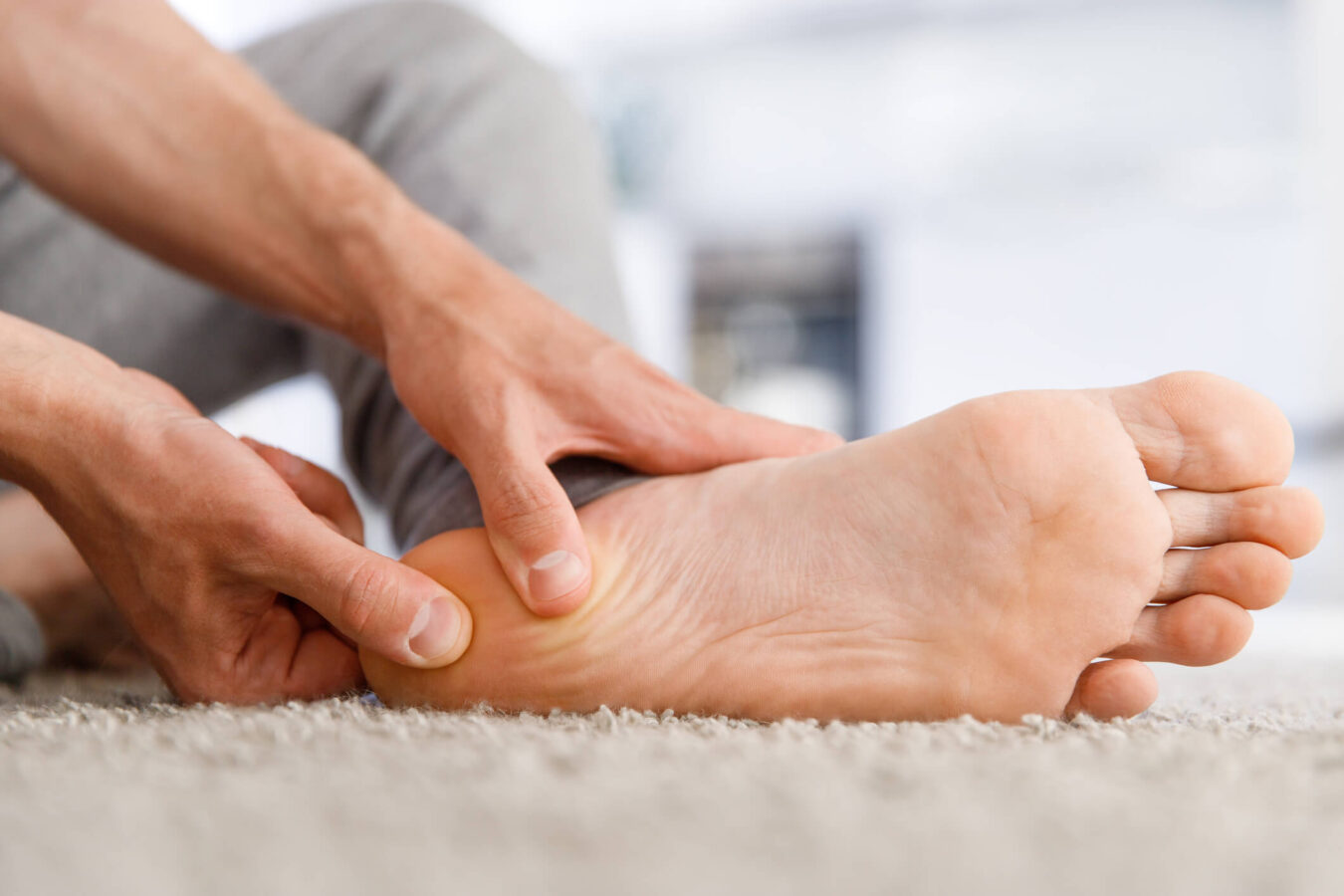
Medically reviewed by Misty Seidenburg
Tarsal tunnel syndrome is compression of the tibial nerve in the ankle that leads to pain, numbness, or tingling in the ankle and throughout the foot. For some people, tarsal tunnel syndrome pain is so intense it makes walking and other activities challenging. While tarsal tunnel syndrome is relatively rare, it is important for those with this condition to take steps to prevent permanent, irreversible nerve damage. One part of a comprehensive approach to treating this condition is with tarsal tunnel syndrome exercises for long-term relief. Here are our top moves to prevent and relieve tarsal tunnel syndrome pain.
The tarsal tunnel is a narrow space that runs along the inside of the ankle. It is covered in a thick ligament (the flexor retinaculum) and contains different arteries, veins, tendons, and nerves that provide foot movement and flexibility.
The tibial nerve is a branch from the spinal nerves that divide down into the legs. It controls muscle movement and transmits sensory messages felt in the knee, foot, and ankle joints. Tarsal tunnel syndrome (TTS) is compression of the tibial nerve. TTS is also sometimes referred to as tibial nerve dysfunction, or posterior tibial nerve neuralgia.
Foot pain located on the inside of the ankle and/or the bottom of the foot is a common sign of TTS. TTS foot pain may be local to this area or extend into the heel, arch, and toes, or up into the calf. Some people with TTS have shooting pain that often comes on after prolonged periods of standing, walking, or exercising. TTS symptoms also include numbness, tingling, or burning sensations like the sensation of an electric shock.
TTS is like carpal tunnel syndrome (CTS), which affects the arm, wrist, and hand and is much more commonly diagnosed. Both arise from the compression of a major nerve within a confined space, and both cause similar symptoms: pain, tingling, and numbness.
It is hard to say how common TTS is because it often goes undiagnosed. It may often be seen along side of other conditions such as posterior tibialis tendinopathy, pes planus (flat foot), among other disorders of the foot.
Several conditions and injuries cause or increase the chance of developing tibial nerve compression:
Healthcare providers generally diagnose TTS with a physical exam, medical history, electromyography (EMG), electrical nerve conduction tests, and imaging studies. TTS affects people of all ages and all stages of life.
The prognosis for TTS really depends on the underlying cause. If a mass is causing nerve compression, symptoms should improve once it is removed. For patients with chronic, systemic conditions, symptoms may be long-term—although, conservative therapies can improve symptoms significantly.
Physical therapy focused on exercise and neural mobility can be combined with orthotic devices, injection therapy and other conservative methods for an integrated approach to symptom relief. Surgery to release the tarsal tunnel and prevent permanent nerve damage may be recommended in more severe cases.
Conservative, nonsurgical therapies are effective for reducing symptoms in many people experiencing TTS. Here are 8 simple yet effective exercises you can do at home to stretch and strengthen the ankle, foot, and lower legs for healthy, pain-free movement.
Ankle resistance exercises are essential for strengthening ankle structures. These moves should be slow and controlled. Discomfort should be mild to moderate. Pain is your sign to stop and rest.
Begin in a seated position on the floor with your right leg stretched out in front of you. Attach one end of a closed elastic resistance band to a fixed object towards the outside of your foot. Place the other end around the top of your flexed foot. Now, turn your foot inward against the band’s resistance and return to the starting position. Do 1-2 sets of 10 repetitions on both feet.
Now, place the resistance band over the top of your foot, just below your toes. Attach the other end to a fixed object directly in front of you. A table or chair leg works well. Gently pull your foot back towards your head and then relax forward and down. Do 1-2 sets of 10 repetitions on both feet.
Return to a seated position. Hold one end of the resistance band and wrap the other around the bottom of your right foot. Push your foot down like you are pushing on a gas pedal and then slowly return your foot to neutral . Do 1-2 sets of 10 repetitions on both feet.
This move also stretches the plantar fascia that runs along the bottom of the foot and connects the heels to the toes and tends to be a common source of foot pain and inflammation.
Ankle rotations improve range of motion in the ankle joint, which helps to prevent injuries that lead to nerve compression or damage.
Start in a seated position on a chair. Lift your right leg a few inches off the ground and rotate the ankle clockwise 5 times and then clockwise 5 times. Place the right foot down. Do 1-2 sets of 10 repetitions on both feet.
This exercise is another way to strengthen the muscles that support the tendons within the tarsal tunnel.
Start in a seated or standing position. Place a pencil on the ground in front of you. (You can also use a marble or small hand towel. Use your toes to pick up the object, hold it for 10 seconds, and place it back down on the floor. Do this 3-5 times on each foot.
The soleus muscle runs along the back of the lower leg. Weakness and/or tightness in this and other muscles of the lower leg and foot can contribute to TTS.
To stretch the soleus, stand with your right foot about 5 inches from a wall in a staggered stance position (left foot behind you).
Keeping your right heel on the floor try to touch your knee to the wall or until you feel a gentle stretch in the back of the right lower calf. Hold that stretch for 45 seconds and repeat 3-4 times on each side.
For the calf stretch, stand up and place your right leg out in front again. This time you will bend the right leg slightly as you straighten the left leg in back. Move forward toward the front leg while keeping both heels on the floor. Stop moving when you feel the stretch in the back leg and hold for 45 seconds. Repeat 3-4 times on each side.
Heel raises are important for strengthening and stretching the posterior tibialis tendon, a key structure of the tarsal tunnel.
Stand in front of a counter or desk. Slowly and with control, lift your heels, leaning your hands on the edge of your surface for support. Hold this “tiptoe” position for 5 seconds before releasing back down to the ground. Do 3 sets of 10 repetitions daily.
As your ankle strength increases, you can try a deeper stretch on a low step. Begin by standing on a low step with just your toes on the surface. Instead of stopping at ground level, you will dip your heels a few inches below the edge of the step. Hold for 5 seconds and return to the starting position. Do 3 sets of 10 repetitions daily.
That really depends. Prevention may include managing underlying, systemic health conditions causing swelling and inflammation. And, of course, you cannot reverse an injury to the foot or ankle. However, you can take steps to keep these structures healthy and lower your risk of TTS foot pain.
Stretch your ankles and feet often, and warm up before working out or playing sports. The exercises above are a great start! Give your body time to recover from intense physical activity and always wear well-made, properly fitting foot wear made for the activity at hand.
TTS symptoms should never be dismissed. Left untreated, foot pain can lead to permanent loss of movement and sensation in the toes or foot, or even mild to severe deformity. Physical therapy should be a key component of your treatment plan. Find a physical therapy clinic near you.

